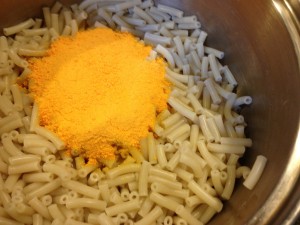Is the infamous macaroni and cheese produced by Kraft causing American children to develop hyperactivity? Some say it is. I heard about the Kraft Macaroni & Cheese controversy a few months ago and ever since that time, I have been wanting to blog about it.
Earlier this year there was story was featured on national news involving two food bloggers and their push to get the food manufacturing giant, Kraft, to remove artificial colors Yellow #5 and #6 from the “original” macaroni and cheese recipe. (1)The bloggers claim that the two dyes lead to hyperactivity in children, are “contaminated with known carcinogens”, and have been linked to asthma, migraines and skin rashes.
If you are wondering from where all of these claims stem or what is the scientific basis of all of the Kraft cheese powder (original recipe) allegations, refer back to the “Southampton 6”, a study conducted by the University of Southampton in the UK which suggested a link between six food dyes-the ’Southampton six’-and hyperactivity in children. In the end, the European Parliament required that products featuring any of the six dyes include warning labels specifying that they “may have an effect on activity and attention in children”. The FDA, unfortunately, has not taken that stance here in the United States.
Unfortunately, Kraft executives opted to keep things as they are...no removal of the artificial colors. According to one source, Kraft executives cite the inability to obtain the yellow cheese color with natural products as one of the main reasons for their decision to keep things as they currently are.

There are Kraft cheese products that are “100% organic and all-natural”, specifically the “Kraft Organic Macaroni and Cheese Dinner”. However, this product along with Kraft’s other organic cheese products are not the ones marketed to children and parents. The “original” recipe, the one containing the dyes, is the one marketed to children. In fact, the cover photo on Kraft’s Facebook page features a “new” original recipe container of Kraft macaroni and cheese shaped like characters from the new children’s movie “Monsters’ University”.
I cannot say whether the claims of hyperactivity are true are not, but it stands to reason that with all of the research conducted in other countries that parents with children, hyperactive or not, should really consider limiting or eliminating the product from their children’s diet. I know that Kraft Macaroni & Cheese is a quick, simple food option, especially for busy parents, but here are some tidbits that offer healthier, safe, and tasty alternatives for you.
- Select favorite pasta; most traditional macaroni and cheese meals use the elbow pasta. (if you want to try the gluten free option, use pastas made with brown rice, organic corn or quinoa. I prefer brown rice pastas; choose from brands like Maplegroves Gluten Free Foods, Tinkyada Pasta Joy, Hodgson Mills, etc.).
- Select your favorite cheddar cheese (if you would like to try the dairy free option use dairy free cheese; I like Daiya Cheddar Cheese)
- Use 2% organic milk (for a dairy free option use coconut milk (light--lower in fat) to achieve the same rich, thick consistency as you get with milk).
- Before draining the pasta after cooking, save 1/2 cup of the pasta water and use it to help melt the cheese instead of using more milk.
- Use a pinch of paprika and turmeric to help make the color stand out more like Kraft’s Macaroni & Cheese; season to your child’s taste!
1Andri Antoniades.“Dyes Derived from Crude Oil Give Mac ’n’ Cheese Its Special Glow.” Takepart. 16 March 16 2013. Web. 18 July 2013. <http://www.takepart.com/article/2013/03/16/kraft-macaroni-and-cheese-contains-harmful-dyes>.








Comments
Comments